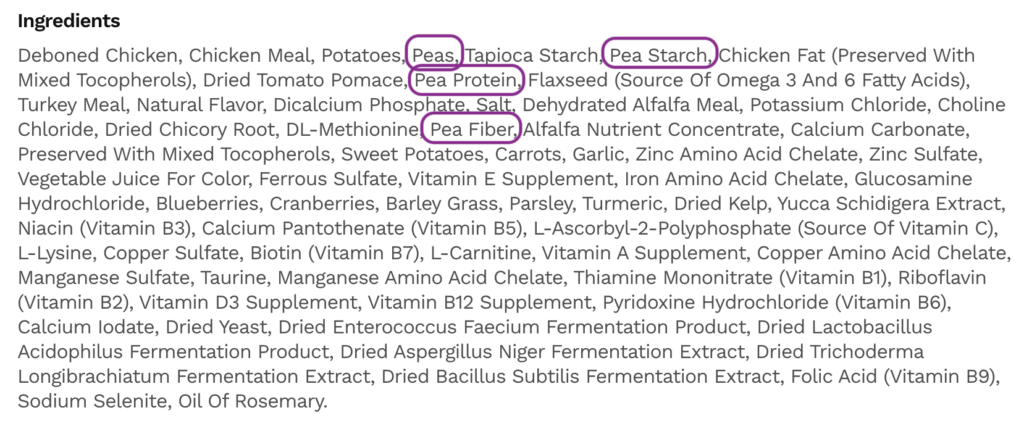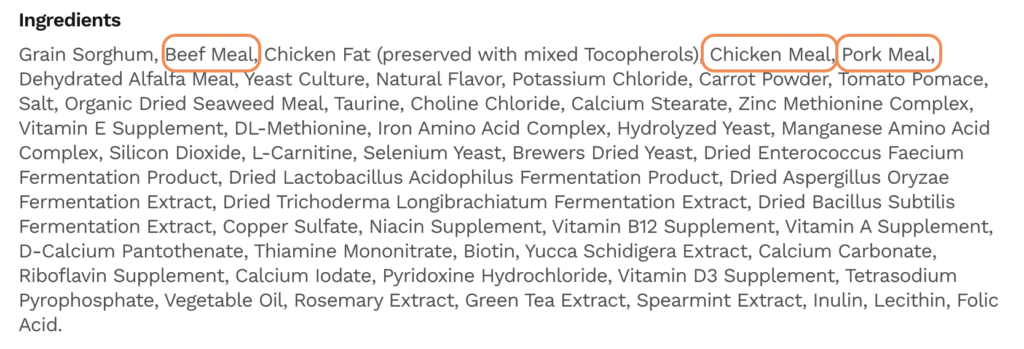There are so many options when it comes to dog food, that choosing the right food for your dog can feel overwhelming! As diligently as we might look for one, there is no perfect dog food. Here are three major items I look for when I am choosing dog food. There are many dog foods on the market that meet this criteria, but these key items help narrow your choices.
I’ve found the best way to evaluate a dog food, is to check out it’s nutrition label. Specifically, what ingredients make up this food? Ingredient labels list out each element included in the dog food. It is important to note that ingredients are listed in a specific order. The ingredient that appears in the largest quantity is first on the list. The ingredient that appears in the least quantity is last on the list.
I am not a canine nutritionist or a veterinarian. If you have concerns about your dog’s health, please consult a veterinarian.
Avoid Grain Free Dog Food
In 2019, the FDA opened an investigation of the rise in cases of Canine Dilated Cardiomyopathy (DCM) and diets containing a high proportion of legumes. Here’s an article from the FDA about DCM and grain-free diets. Canine Dilated Cardiomyopathy or DCM is a heart disease in dogs, that weakens the heart’s contractions and pumping ability. This is a progressive and irreversible condition.
As part of the grain-free movement, large dog food producers have replaced grain ingredients with legume ingredients. Because grain-free dog foods, have an increased number of legumes, which is linked with DCM, I recommend staying away from a grain-free or legume heavy diet.
Generally, the grain-free food companies are smart and break the legumes down into multiple parts and often incorporate multiple types so that legumes don’t appear to be a main ingredient at a glance. But if you add up all the parts or different types, they truly are a main ingredient. Let’s break down this Blue Buffalo Freedom Grain-Free Dry Dog Food as an example. In the first 10 ingredients, peas are used 3 times. You can also notice that a little further down the list, peas are used again!

Grain-free diets are not the only diets to be concerned about. Let’s checkout this popular Hill’s Science Diet Sensitive Stomach Adult Dog Food. This is not marketed as a grain-free dog food, yet yellow peas are the third ingredient. That means, a high percentage of this food is legume based.

Avoid Dog Food Containing Genetically Modified Ingredients
A Genetically Modified Organism (GMO) is a living organisms that’s very genes have been artificially altered in a laboratory. Generally, GMOs are altered to withstand applications of herbicide and insecticides. Corn and Soy are the two most genetically modified foods in America. While GMOs are regulated to ensure safety to their consumers, I avoid dog foods containing GMO ingredients, especially corn and soy.
Not only are GMO crops unnatural, they likely contain traces of harsh chemicals intended to kill specific organisms. I don’t want my dogs consuming that kind of food! Dog food manufacturers will use some kind of grain or legume to bind their foods together. Look for a food containing wheat or rice, rather than corn or soy.
I avoid Royal Canin food specifically for this reason. Not all, but many of their foods have Corn as their first ingredient. Royal Canin is a popular food among breeders as they offer benefits to breeders. I quickly found their Royal Canin Breed Poodle Dog Food on Chewy and saw that Corn is the first Ingredient.

Choose Multiple Sources of Protein
Dogs are opportunistic eaters. If something looks like it might be food, they will taste it out! Their wild ancestors would graze among meats and plants alike to find food. It is natural for dogs to regularly eat a variety of meat, which is why I prefer dog foods with multiple sources of protein.
Eating one item everyday for an extended period of time, even if it’s healthy, can cause nutritional deficiencies over time. Including multiple proteins in your dog’s diet helps prevent those deficiencies. Some studies have shown that feeding a dog a food with multiple proteins can lessen their likelihood to develop an allergy to sensitivity to a particular protein over time. As an example, checkout these ingredients from VICTOR Classic Multi-Pro Dog Food.

You will notice in the VICTOR dog food ingredients above, the proteins are listed using the word “meal”. This term refers to the dehydrated version of the protein itself. Let’s say a company adds 1 pound of raw chicken into the dog food batch. After processing that batch and drying it into kibble, there may only be 1/4 pound of chicken in that kibble. This is because the water portion of the raw chicken was removed in order to make dry dog food. In the same batch of dog food, let’s say the company added 1 pound of chicken meal. After processing that batch into dry kibble, there is still 1 pound of chicken meal in that batch. This is because the water content was already removed before adding it to the batch. For equal amounts of chicken and chicken meal in the same dog food, we ultimately end up with significantly more protein from chicken meal.

